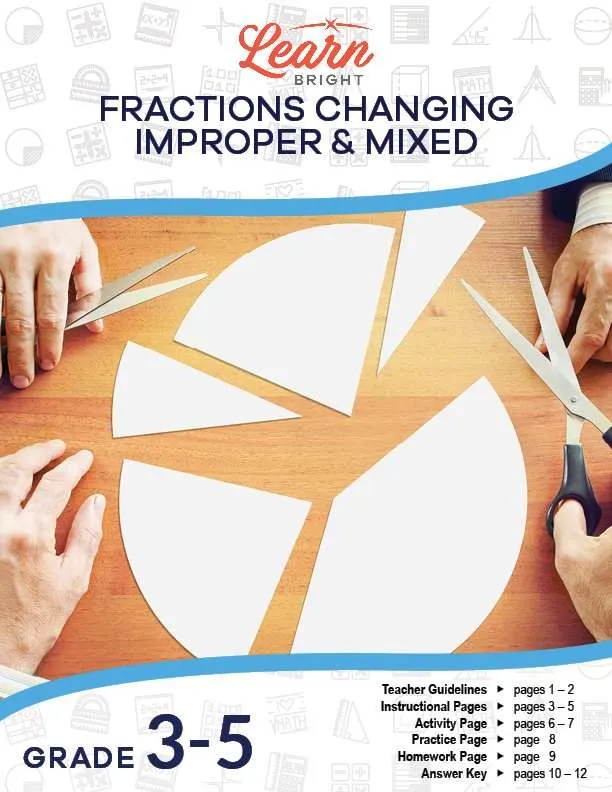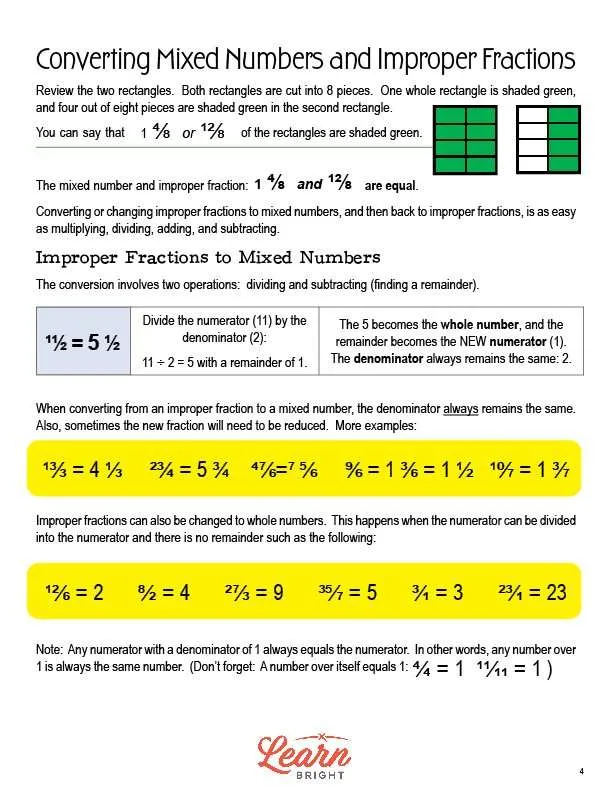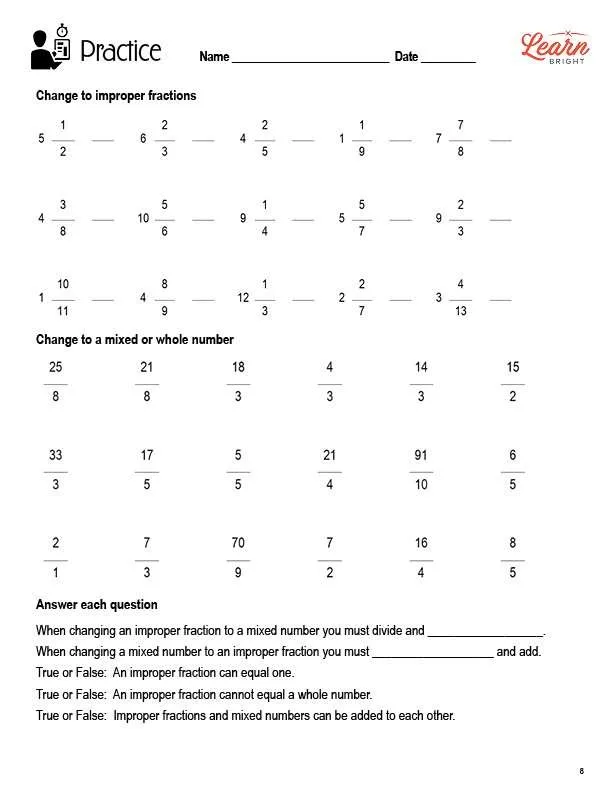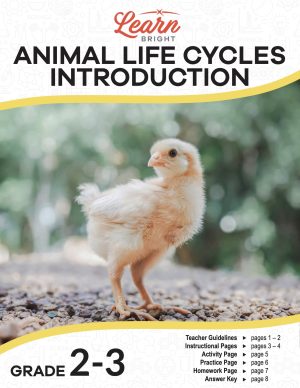Description
What our Fractions Changing Improper and Mixed lesson plan includes
Lesson Objectives and Overview: Fractions Changing Improper and Mixed tackles the conversion of improper fractions and mixed numbers. At the end of the lesson, students will be able to convert mixed numbers to improper fractions and convert improper fractions to mixed numbers. The students will also be able to identify a whole number as a fraction using one as the denominator. This lesson is for students in 3rd grade, 4th grade, and 5th grade.
Classroom Procedure
Every lesson plan provides you with a classroom procedure page that outlines a step-by-step guide to follow. You do not have to follow the guide exactly. The guide helps you organize the lesson and details when to hand out worksheets. It also lists information in the blue box that you might find useful. You will find the lesson objectives, state standards, and number of class sessions the lesson should take to complete in this area. In addition, it describes the supplies you will need as well as what and how you need to prepare beforehand.
Options for Lesson
Included with this lesson is an “Options for Lesson” section that lists a number of suggestions for activities to add to the lesson or substitutions for the ones already in the lesson. One optional adjustment to the lesson activity is to use hands-on manipulatives to show the improper fractions and mixed numbers. To add to this lesson, you can teach it in conjunction with a lesson on adding/subtracting mixed numbers. To test your students’ understanding of the lesson material, you could use the practice page and/or the homework page as a brief test or quiz.
Teacher Notes
The teacher notes page includes a paragraph with additional guidelines and things to think about as you begin to plan your lesson. This page also includes lines that you can use to add your own notes as you’re preparing for this lesson.
FRACTIONS CHANGING IMPROPER AND MIXED LESSON PLAN CONTENT PAGES
Improper Fractions
The Fractions Changing Improper and Mixed lesson plan includes three pages of content. When most people hear the word improper, they may think of something that’s incorrect. However, an improper fraction is not incorrect, it’s just a fraction with a numerator that’s larger than its denominator.
Up to this point, students have likely only seen proper fractions, like 1/2, 3/7, 5/9, or 4/11. Improper fractions are a little different, like 3/2, 5/4, and 8/3. Improper fractions often show up when adding two or more proper fractions together. For example, 3/5 + 3/5 = 6/5, which is an improper fraction.
Improper fractions can give you valuable information. For example, if you say you ate 12/8 of a pizza, that means that more than one pizza was cut into eights, and you ate more than one whole pizza. We don’t use improper fractions very often, and typically change them into mixed numbers.
Mixed Numbers
Mixed numbers are numbers that contain a whole number and a fraction, such as 3 1/2 or 4 2/5. It’s not very common, but mixed numbers can include an improper fraction, like 2 5/4.
If you ate two and a half pizzas, it’s very easy to understand when written as a mixed number: 2 1/2. We use mixed numbers much more often than improper fractions. However, you can change a mixed number to an improper fraction as well.
Converting Mixed Numbers and Improper Fractions
The lesson shows how to convert mixed numbers and improper fractions using an example. In this example, there are two rectangles that are both cut into 8 pieces. One whole rectangle is green, while four of the eight pieces of the other rectangle are green. To write this as a number, you could write that either 1 4/8 or 12/8 of the rectangles are green. The mixed number 1 4/8 and the improper fraction 12/8 are equal.
Improper Fractions to Mixed Numbers
Converting improper fractions to mixed numbers uses two operations, division and subtraction. For example, to covert 11/2 to a mixed number, you first divide the numerator (11) by the denominator (2): 11 / 2 = 5 with a remainder of 1. The five becomes the whole number and the remainder become the new numerator. The denominator remains the same. Therefore, 11/2 as a mixed number is 5 1/2.
When converting from an improper fraction to a mixed number, you never change the denominator. However, there are times when the new fraction needs to be reduced. For example, the improper fraction 9/6 becomes the mixed number 1 3/6, which we then reduce to our final answer of 1 1/2.
We can also change some improper fractions to whole numbers, but only when the numerator can be divided into denominator without a remainder. For example, 12/6 = 2. Remember that any fraction with a denominator of 1 always equals the numerator.
Mixed Numbers to Improper Fractions
Converting a mixed number to an improper fraction uses the opposite operations as above, multiplication and addition. For example, to convert 2 3/7 to an improper fraction, you first multiply the whole number (2) by the denominator (7) then add the numerator (3) to the result: (2 x 7) + 3 = 17. The 17 become the new numerator and the denominator remains the same. Therefore, 2 3/7 as an improper fraction is 17/7.
When converting from a mixed number to an improper fraction, you never change the denominator. Sometimes, the improper fraction needs to be reduced. For example, the mixed number 6 2/4 becomes the improper fraction 26/4, which we then reduce to our final answer of 13/2.
FRACTIONS CHANGING IMPROPER AND MIXED LESSON PLAN WORKSHEETS
The Fractions Changing Improper and Mixed lesson plan includes three worksheets: an activity worksheet, a practice worksheet, and a homework assignment. You can refer to the guide on the classroom procedure page to determine when to hand out each worksheet.
CONVERSION ACTIVITY WORKSHEET
The activity worksheet asks students to convert each fraction to either an improper fraction or a mixed number, including a sketch for each.
SOLVING PROBLEMS PRACTICE WORKSHEET
For the practice worksheet, students will first change mixed fractions to improper fractions. Next, they will change improper fractions to mixed or whole numbers. Finally, they will answer a few questions about the lesson material, including a few true or false questions.
FRACTIONS CHANGING IMPROPER AND MIXED HOMEWORK ASSIGNMENT
The homework assignment asks students to solve five word problems. They will then use mental math to compare fractions using <, >, or =. Finally, they will write an improper for each whole number.
Worksheet Answer Keys
This lesson plan includes answer keys for the activity worksheet, the practice worksheet, and the homework assignment. If you choose to administer the lesson pages to your students via PDF, you will need to save a new file that omits these pages. Otherwise, you can simply print out the applicable pages and keep these as reference for yourself when grading assignments.









